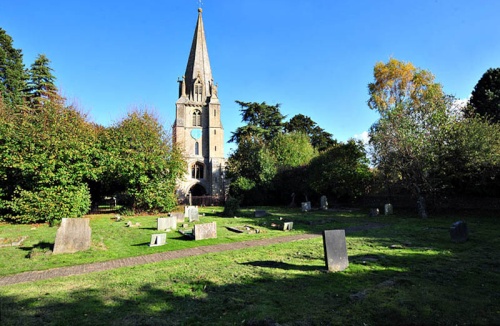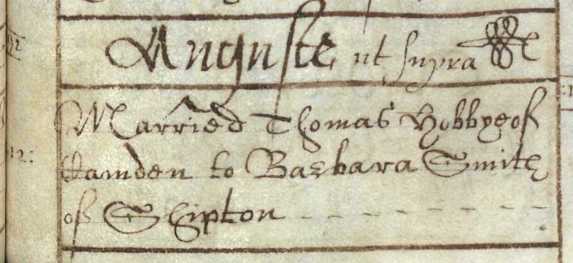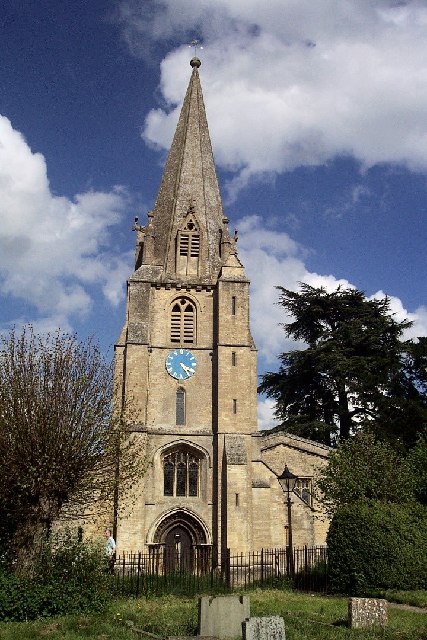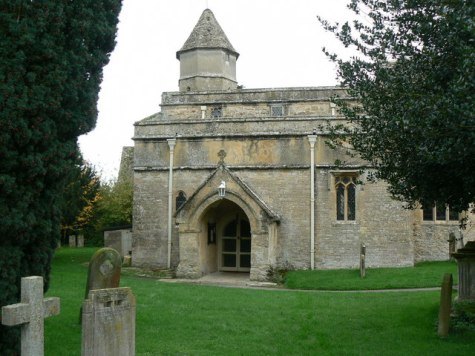
St Mary the Virgin, Shipton under Wychwood
As one delves deeper into family history, the burden of proof on a fact or relationship necessarily loosens. Whereas the nineteenth century is fairly rich in documentation that can back up the basic assumptions and give a sheen of truth (paternity always remains a theory!), the records of the eighteenth century and earlier must too often force one to give way to the presumption of “most probable” or even “possible”.
In a previous article (here) I gave my reasoning for the identification of the Richard Burson who died at High Cogges in 1725 with the individual of the same name who was born in Milton under Wychwood in 1643 and had his children baptised at St Mary the Virgin, Shipton under Wychwood from 1670 to 1696. I feel the evidence is strong and almost falls into the category “proven”. With this in mind I have attempted to trace this line back further, and through the female line I have been more successful than I dared hope.

Marriage of William Burson and Katherine Careles 1587
The parents of Richard Burson were William and Joan (nee Hobby) who married at St Mary’s, Shipton (where all the following details are recorded in the parish register) on November 23, 1629. They had five children baptised in Shipton, Richard being the youngest. Apart from his being a churchwarden for the village of Milton under Wychwood (part of Shipton parish) in 1669, I have so far been unable to find out little more about William. He is recorded as having signed (or marked) the Protestation of 1641, along with his brother, Thomas and nephew, Richard. He died in 1674, and his wife Joan had died five years previously. He was the son of another William Burson who had married Katherine Careles in 1587. The parish register entry (above) records that William came from the parish of Willersey “in Worstershire” – it is now in Gloucestershire and may always have been, but it is very close to the county boundary. Sadly the registers there do not survive before 1600 and it may be impossible to take the Burson line back much further. There are some Burson wills for Willersey, and that of John Burson in 1579 mentions the testator’s youngest son, William who is bequeathed 50/-. Without the registers to confirm whether or not William is mentioned again, it is difficult to be certain that this is the same individual. We do know that the William who heads the Milton line was a carpenter, as this is stated at the baptism of his son, Thomas, and when he died in 1623, he left a will with bequests to his two sons, William and Thomas and the remainder of his estate to his wife, Katherine. The inventory of his goods values the estate at £7 18s 4d.

The mark of William Burson on his will of 1623
Turning to Joan Hobby, her baptism is recorded at St Marys on November 14, 1602, where her father is named as Thomas Hobby of Shipton. Thomas had married Barbara Smith in 1591 and the register of St Marys describes him as “of Camden”, which I take to be Chipping Campden in Gloucestershire. Like Willersey the registers of Chipping Campden do not survive for this period (they commence in 1616) so we cannot take Thomas’ line any further back. He and Barbara had a son, also named Thomas and eight daughters. Thomas junior is probably the individual who appears in the registers of Ascott under Wychwood from 1621, and at least two other daughters married in Shipton, besides Joan. Thomas Hobby senior served as churchwarden there in 1595 and 1610-1.

Marriage of Thomas Hobby and Barbara Smith 1591
I have a had more success with the Smith family from which Barbara hailed. Despite there being several Smith families in Shipton at this period, it is possible to trace some of the lines. Barbara was christened in 1568, probably the youngest child of Thomas and Alice Smith (nee Andros – most likely a local spelling of Andrews). A brother, John was baptised the day before her, but was buried on the day of Barbara’s baptism, May 2nd. It is likely that they were twins and John was baptised in a hurry as he was sickly from birth. Thomas served as churchwarden of Shipton (the family, like the Hobbys always appear as residents of Shipton) in 1585 and at his burial in 1587 he is described as a “freehoulder”. He too left a will but no inventory survives so we cannot be sure of his economic status. He was certainly fairly prosperous though. He left money bequests to his two surviving unmarried daughters, Denys (spelt Deans in the will) and Barbara (spelt Barrbrowe) of £13 6s 8d each, to be payed when they married or attained the age of 23. He also left bequests to his son, Rafe (Ralph), his two sons-in-law, Rafe Brayne and Richard Cooke (who belonged to a wealthy butcher family) as well as to his eight grandchildren who mostly received “on shype” – one sheep. There are also bequests for the children of his brother, Richard as well as his “best coote …..and brychys” for Richard himself.
The mention of his brother and the names of his children make it possible to take the line back one further generation, perhaps. Although the parish register of St Marys, Shipton under Wychwood commence in 1538 and are fairly complete, if a little muddled in places, there are infuriating periods when the parentage of children being baptised is not given; so one has “Christened Elizabeth Smith” and the date. To add to the confusion, there was certainly another pair of brothers in Shipton named Thomas and Richard Smith. These are often distinguished however, by the addition of “Mr.” or “gent” or “servant to Sir Edward Unton” (the lord of the manor of Shipton at the time), whereas Barbara’s family are normally “of Shipton”.
There is the will of one Nicholas Smith who was buried in Shipton on August 6 1562, in which he leaves the bulk and remainder of his estate to his son, Richard. There are however, two bequests to Rafe Smith and Jane Smith, the children of Thomas. There is no mention of a relationship, but they come at the head of the list of legacies and it must be assumed that Thomas is another son and the children mentioned, Nicholas’ grandchildren. In 1561, Barbara’s father, Thomas Smith would have had just the two children – Rafe and Jane. These names do not seem to repeated in any other of the Smith families in Shipton. It is possible that Nicholas fell out with Thomas, but was minded to remember his grandchildren, or it may just be that Thomas inherited the land tenancies whilst Richard did not share in them.

Marriage of Thomas Smith and Alice Andros
Thomas Smith had married Alice Andros on November 18, 1548, and at his burial in 1587 it is noted that he was “allmost or about 60 yeare oulde”. This would place his birth around 1527, so it is more than likely that Nicholas, if indeed he was Thomas’ father, would have been born very close to 1500. In the Victoria County History of the parish of Shipton under Wychwood (not yet published but available in draft online) there is mention of one of the sokemen (a class of free tenant of a manor) of Shipton, Nicholas Smith, who held c170 acres of manorial land in 1547. A study of the manorial court records of Shipton may deliver the answer to the descent of the Smith family and could possibly take the line back into the 15th century or before.
Ilustrations courtesy of the Oxford History Centre.
I have standarised the spellings for clarity’s sake – Smith often occurs as Smythe in the registers, and Hobby as Hobbie.
I am in the process of transcribing the three wills mentioned and they will appear in due course on the OHFS transcribed wills site (here)




You must be logged in to post a comment.